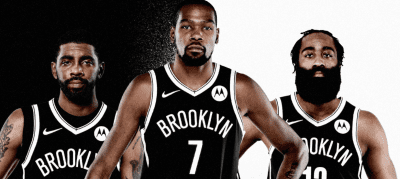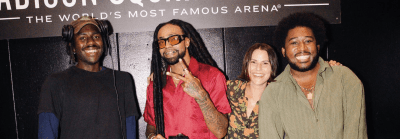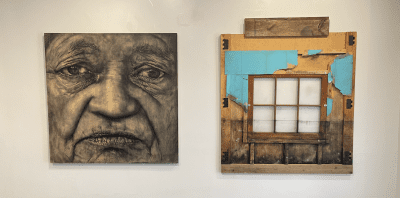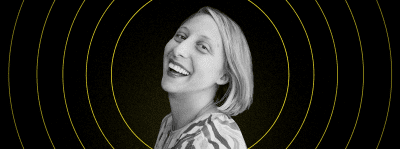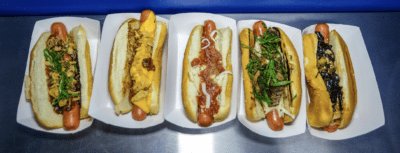Goodman with the Nike KD15 (Curtis Rowser)
The artist behind the new Kevin Durant Nike: ‘these sneakers are for Brooklyn’
Timothy Goodman's work has appeared on walls, in galleries and magazines, on brands, and now a pair of Nikes. Next up: a memoir
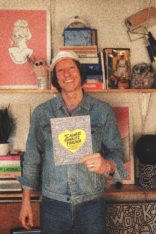

Goodman and his book (Rowser)
You’ve seen Timothy Goodman’s work even if you may not know the name: His unique, graffiti-style art has lept from walls and buildings into galleries, books and magazines, and ultimately onto apparel worldwide for prominent brands like Apple, Google, Uniqlo, Target, and YSL, among others.
But 2022 was something of a watershed year for Goodman. The artist, who had previously worked with The Kevin Durant Foundation — he painted a 5500 square-foot court the Brooklyn Nets superstar donated to PS 315 in September 2020 — was tapped to design the Nike KD15, the 15th iteration of Durant’s flagship sneaker. The Nike KD15 “Timothy Goodman” dropped last month. The sneakers are colorful and bold, with a black base and thick white graffiti-style lettering spanning the entire silhouette. The KD15 “Timothy Goodman” evokes a style that was popular in the 1980s, reminiscent of New York-based Spike Lee films that inspired Goodman.
Later this month, Goodman — who grew up in hardscrabble Cleveland and moved to New York 18 years ago — is putting out his third book, “I Always Think it’s Forever,” published by Simon & Schuster. The book is a chronicle of his time in Paris after a bout with depression in 2018. It’s currently available for pre-order.
Brooklyn Magazine sat down with Goodman in his new studio in Tribeca to discuss his current crop of projects, his troubled upbringing and what to expect next.
What was the art scene like in Cleveland when you were growing up?
Both my grandparents are artists. They were just really cultured. They would take me to plays and all this stuff. There’s a strong art scene out there. There’s the Cleveland Institute of Art, where my grandmother would teach classes, so I was around it a lot. But when I was a teenager, I rebelled against it. Then at some point, I realized, “I’m an artist, I have to find my footing with this.”
Do you remember where you were at mentally and emotionally when you made the decision to move here 18 years ago?
Dude, I felt like I belonged here before I ever came. I visited for the first time, maybe a year before I moved here. But my whole life, I just felt like I belonged here. And when I got here, it was so reaffirming. I feel like I’ve never had a moment, ever, where I was regrettably like, “Oh shit.”
So, was it an easy transition for you?
It was pretty easy. The only thing was leaving my life back in Cleveland. I moved here to go to SVA [the School of Visual Arts]. I went to community college in Cleveland and had some incredible teachers. I was a complete fuckup in high school. I barely graduated, I smoked weed every day, did every kinda drug, got suspended so many times. My GPA was like a 1.6 or something. I couldn’t even get into any of the basic state universities. So, I started painting homes and taking these community college classes. At that time, I became really motivated to prove people wrong who thought I was just this fuckup who would never become anything. Thanks to therapy, I can see that now and connect the dots. I was just really motivated to be something, but I only wanted to do that on my terms. I just had to save enough money to get [to New York].
Did you have a Plan B?
There was no Plan B, man. I came here and was like, “I gotta make this work. It’s either this or I gotta go back to Cleveland and paint homes.” In hindsight, I didn’t have any fun in college. It was not school, it was nonstop work and hustle. Every moment, I was making portfolio books, tryin’ to get more scholarship money, and trying to overachieve in any and everything, because I just knew I had to figure out how to stay here.
You’ve worked with huge companies like Nike, Target, etc. When you’re working with these big corporations, what are some things you’re never willing to compromise as an artist?
I don’t wanna work with any brand that is outwardly affiliated with some sort of racist, or misogynist, or homophobic platform or ideology, you know what I mean? But here’s the thing, I’m also a hypocrite because you can probably go down the line on any brand and find something. I just think it’s important for all of us to have more nuance in these discussions. You just gotta figure it out for yourself and do your own research. That’s what I try to do — do my own research and make the call.
Did you always feel that you have social responsibility as an artist? If so, how has that changed from the beginning of your career to now as a popular artist, and with the advent of social media?
Any artist has a responsibility with what we’re putting out in the world. There’s no right or wrong in any of this stuff. As long as you’re questioning things and looking at things critically, then I think you’re somewhat in the realm of being okay. If you’re not looking into how everything you do relates to the people around you in some way, that’s just not for me. As an artist, it’s also my job to be informed about what’s going on in society and maybe sometimes respond to that and throw a mirror back at it.
So, getting to the KD15. You recently said these were two years in the making. Can you speak about what went into these from ideation to completion?
It all started, obviously, with the basketball court for Kevin’s charity foundation that I created for the students at PS 315 in Brooklyn. Not long after that, Nike’s team reached out to me and was like, “We have to start thinking about the KD15s.” Kevin and Kevin’s team all felt like we wanna take the art from the court and use that similar style and similar characteristics to bring onto the shoe. The Nike Basketball team never worked with an independent artist. At first, it was a lot of preliminary talks, and at some point, I thought it was not gonna happen. It was this slow-moving machine ‘til the end.
When you got word that there was an official release date, what was that like for you?
You know what’s wild, is like over the summer when the whole thing happened with Kevin, and he demanded a trade, I remember I wrote them. The shoes were out, I gave them the final files in like April. I was like, “wait if he goes to another team, this shit says Brooklyn all over them.” But they were like, “It doesn’t matter, these sneakers are still for Brooklyn, for the community.” But I don’t remember exactly when I got the date.
Were you and Kevin in contact throughout the process?
I never met Kevin until I met him at the game. But I would always hear that he thought they were dope or whatever. Man, his team was incredible. I really wanted to nail this, I didn’t want to give a lot of room for error. I did 150 variations of them. This was one of the easiest collabs I ever did. Straight up, I went into this wanting to make the dopest basketball shoe I ever seen. Something that really converts from Kevin on the court, the performance, to the streets. I thought a lot about making the art small enough to get a lot of content on the sneaker, but big enough that you can see it. To me, that’s the homage to Brooklyn, to New York City, to graffiti art, to the artists from the ‘80s that I’m inspired by. I wanted to capture that.
Can you speak more about your upcoming book, “I Always Think it’s Forever”?
It’s a graphic memoir about how I went to Paris for six months. It was a joy, man. I designed every inch of this book. It’s a story about going to Paris and rediscovering myself after a year of depression that I had in 2018. I vowed to do everything I put off before. Then I fell in love with this Parisian woman, which is the catalyst of this book. It’s 18 chapters from falling in love to heartbreak and all the grieving processes in between.
Having worked with all these major brands and having all these successes, what’s your why?
Honestly, at this point how I think about it, my New Year’s resolution is to be at service. That’s my why. Community. How do I be at service, how do I help people, how do I use my platform and privileges to open up things for others? I want to connect to people as much as possible, that’s what I’m in it for. The shit’s good to do brand deals and make money or whatever, but at the end of the day, how do I really connect to another human being through my art form and how do we have a dialogue about that?
Do you have any bucket list items left? Any bucket list collaborations?
Not really. Maybe I should. Honestly, my bucket list right now is making more time for friends, family, my girlfriend, and me. Making more time for the spiritual side of things. Making more time to sit in peace. I want more of that. I still want the ruckus. I like all that, it’s what keeps me going. But I need the chaos, I thrive in it in a lot of ways. But if it’s too much, you get burned out. And I’ve been burned out before, and I suffered from that. That’s just my bucket, man. Keep tryin’ to find that balance and keep listening to my heart and what I need as a person and what I need for my mental and my mental health. Once that goes, none of this shit matters, man.
You might also like 

















